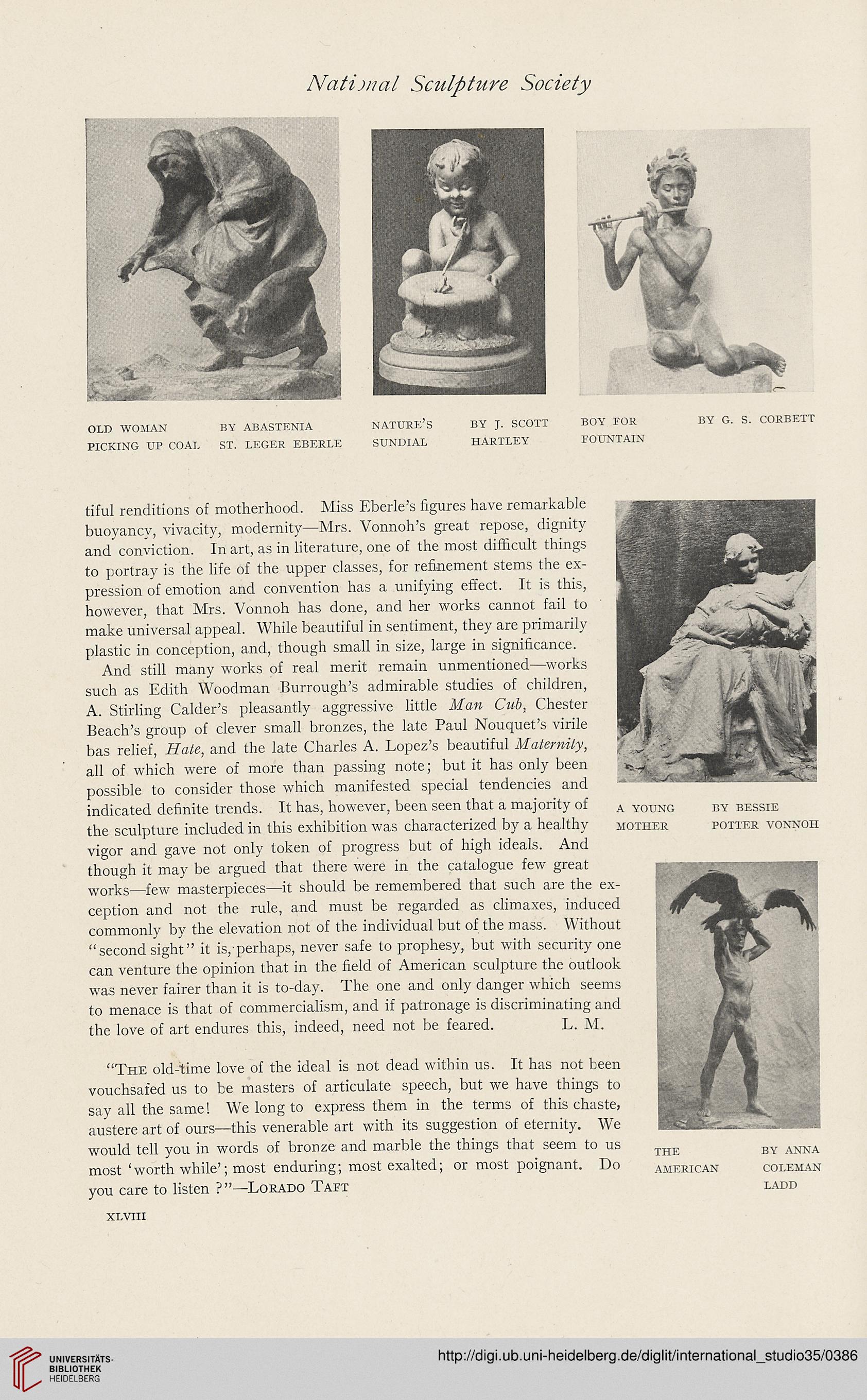National Sculpture Society
OLD WOMAN BY ABASTENIA NATURE’S BY J. SCOTT
PICKING UP COAL ST. LEGER EBERLE SUNDIAL HARTLEY
BOY FOR
FOUNTAIN
BY G. S. CORBETT
tiful renditions of motherhood. Miss Eberle’s figures have remarkable
buoyancy, vivacity, modernity—Mrs. Vonnoh’s great repose, dignity
and conviction. In art, as in literature, one of the most difficult things
to portray is the life of the upper classes, for refinement stems the ex-
pression of emotion and convention has a unifying effect. It is this,
however, that Mrs. Vonnoh has done, and her works cannot fail to
make universal appeal. While beautiful in sentiment, they are primarily
plastic in conception, and, though small in size, large in significance.
And still many works of real merit remain unmentioned—works
such as Edith Woodman Burrough’s admirable studies of children,
A. Stirling Calder’s pleasantly aggressive little Man Cub, Chester
Beach’s group of clever small bronzes, the late Paul Nouquet’s virile
bas relief, Hate, and the late Charles A. Lopez’s beautiful Maternity,
all of which were of more than passing note; but it has only been
possible to consider those which manifested special tendencies and
indicated definite trends. It has, however, been seen that a majority of
the sculpture included in this exhibition was characterized by a healthy mother potter vonnoh
vigor and gave not only token of progress but of high ideals. And
though it may be argued that there were in the catalogue few great
works—few masterpieces—it should be remembered that such are the ex-
ception and not the rule, and must be regarded as climaxes, induced
commonly by the elevation not of the individual but of the mass. Without
“second sight” it is, perhaps, never safe to prophesy, but with security one
can venture the opinion that in the field of American sculpture the outlook
was never fairer than it is to-day. The one and only danger which seems
to menace is that of commercialism, and if patronage is discriminating and
the love of art endures this, indeed, need not be feared. L. M.
“The old-time love of the ideal is not dead within us. It has not been
vouchsafed us to be masters of articulate speech, but we have things to
say all the same! We long to express them in the terms of this chaste,
austere art of ours—this venerable art with its suggestion of eternity. We
would tell you in words of bronze and marble the things that seem to us
most ‘worth while’; most enduring; most exalted; or most poignant. Do
you care to listen ?”—Lorado Taft
THE BY ANNA
AMERICAN COLEMAN
LADD
XLVIII
OLD WOMAN BY ABASTENIA NATURE’S BY J. SCOTT
PICKING UP COAL ST. LEGER EBERLE SUNDIAL HARTLEY
BOY FOR
FOUNTAIN
BY G. S. CORBETT
tiful renditions of motherhood. Miss Eberle’s figures have remarkable
buoyancy, vivacity, modernity—Mrs. Vonnoh’s great repose, dignity
and conviction. In art, as in literature, one of the most difficult things
to portray is the life of the upper classes, for refinement stems the ex-
pression of emotion and convention has a unifying effect. It is this,
however, that Mrs. Vonnoh has done, and her works cannot fail to
make universal appeal. While beautiful in sentiment, they are primarily
plastic in conception, and, though small in size, large in significance.
And still many works of real merit remain unmentioned—works
such as Edith Woodman Burrough’s admirable studies of children,
A. Stirling Calder’s pleasantly aggressive little Man Cub, Chester
Beach’s group of clever small bronzes, the late Paul Nouquet’s virile
bas relief, Hate, and the late Charles A. Lopez’s beautiful Maternity,
all of which were of more than passing note; but it has only been
possible to consider those which manifested special tendencies and
indicated definite trends. It has, however, been seen that a majority of
the sculpture included in this exhibition was characterized by a healthy mother potter vonnoh
vigor and gave not only token of progress but of high ideals. And
though it may be argued that there were in the catalogue few great
works—few masterpieces—it should be remembered that such are the ex-
ception and not the rule, and must be regarded as climaxes, induced
commonly by the elevation not of the individual but of the mass. Without
“second sight” it is, perhaps, never safe to prophesy, but with security one
can venture the opinion that in the field of American sculpture the outlook
was never fairer than it is to-day. The one and only danger which seems
to menace is that of commercialism, and if patronage is discriminating and
the love of art endures this, indeed, need not be feared. L. M.
“The old-time love of the ideal is not dead within us. It has not been
vouchsafed us to be masters of articulate speech, but we have things to
say all the same! We long to express them in the terms of this chaste,
austere art of ours—this venerable art with its suggestion of eternity. We
would tell you in words of bronze and marble the things that seem to us
most ‘worth while’; most enduring; most exalted; or most poignant. Do
you care to listen ?”—Lorado Taft
THE BY ANNA
AMERICAN COLEMAN
LADD
XLVIII




